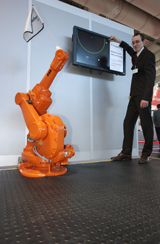Robots get an artificial skin
Robots are breaking barriers: Long banished behind steel barriers, they are entering new fields of application such as the manufacturing, household and healthcare sectors. The requisite safety can be provided by a tactile sensor system, which can be integrated in a floor or applied directly to robots as an artificial skin.
A mobile robot carefully transports a sample through a biotech lab where it is surrounded by the routine hustle and bustle. Lab technicians are conversing with one another and performing tests. One technician inadvertently runs into the robot, which stops moving immediately. An artificial skin covering the robot makes this possible. Consisting of conductive foam, textiles and an intelligent evaluation circuit, the sensor system detects points of contact and differentiates between gentle and strong contact. It registers people immediately. The shape and size of the sensor cells implemented in the skin can be varied depending on the application. They detect any contact. The higher the number of sensor cells, the more precisely a point of collision can be detected. A sensor controller processes the measured values and transmits them to the robot or, alternatively, a computer, a machine or production line.
Researchers at the Fraunhofer Institute for Factory Operation and Automation IFF in Magdeburg designed and patented this sensor system in 2008 for its assistant robot LiSA, which stocks incubators and measuring instruments in biotech labs with sample cups and relieves lab staff from such work. Since then the engineers have refined the sensor system for a wide array of applications such as industrial robots and flooring. Contact with humans or objects will be reliably detectable in the future, a basic prerequisite for the implementation of robots in human environments without protective barriers. »Our artificial skin can be adapted to any complex geometry, including curved or very flat. We use large-area floor sensors to define safety zones that people may not enter«, says Markus Fritzsche, researcher at the Fraunhofer IFF. »These areas can be changed dynamically.« The tactile skin now also functions as an input medium, for instance, to guide robots by translating contact into motion. »This requires little force. If I touch the robot, it attempts to evade the pressure. Thus, I can direct even a 200 kilogram robot in the desired direction«, says Fritzsche describing the system’s advantages. Another of the artificial skin’s distinctive features is the integrated damping elements that additionally diminish any collisions by cushioning impacts.
Diverse variants of the tactile sensor system now exist, the shell material ranging from breathable to waterproof. »This opens entirely new fields of application such as medical engineering or manufacturing«, says Fritzsche. »Pressure sensitive flooring is ideal for monitoring workspaces in factories or instantly registering fallen patients in a nursing home for instance. Robots and mobile equipment outfitted with the artificial skin register any collision and brake immediately. In addition, we can provide robot grippers a sense of touch and thus detect whether they are actually gripping something.«
Numerous variants of the artificial skin have been prototyped. Fritzsche is convinced: »We’ll encounter all sorts of forms of artificial skin in everyday life in the near future.«
